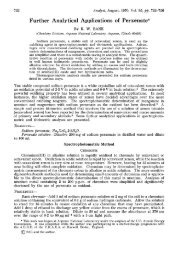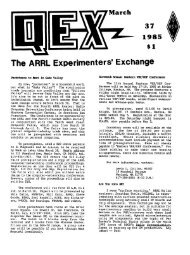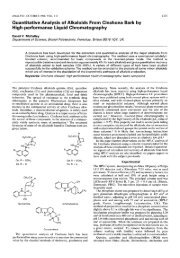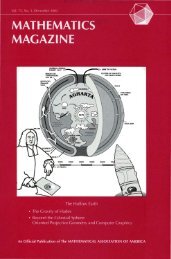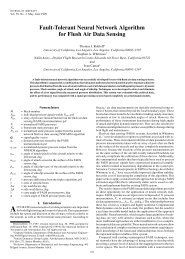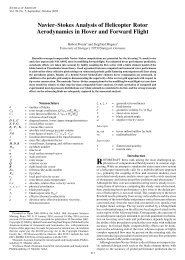pdf 6436KB Sep 25 2010 04
pdf 6436KB Sep 25 2010 04
pdf 6436KB Sep 25 2010 04
- TAGS
- 81.70.242.211
You also want an ePaper? Increase the reach of your titles
YUMPU automatically turns print PDFs into web optimized ePapers that Google loves.
Contest Tips, Tricks and Techniques Gary Sutcliffe, W9XT<br />
Strengths and Weaknesses<br />
In sports competition you always want<br />
to apply your strengths against your opponent’s<br />
weaknesses. While radio contests<br />
are not direct head-to-head confrontations,<br />
it still makes sense to make the best use<br />
of your strengths and to minimize the effects<br />
of your weaknesses. This installment<br />
of CTT&T looks at what some contesters<br />
consider to be their strengths and weaknesses<br />
and how they adjust their operating<br />
techniques accordingly.<br />
Geography and Location<br />
Unlike most sporting events where<br />
the players are on the same fi eld, radio<br />
contesting has a very uneven playing<br />
fi eld. Different regions experience different<br />
propagation. Within a given region,<br />
geography can have a big effect on station<br />
performance. Everyone wants to be on top<br />
of the big hill in the middle of a salt marsh,<br />
but few of us are that fortunate.<br />
From North America, New England and<br />
Maritime Canada enjoy an advantage<br />
toward Europe with its multiplier-rich population<br />
centers. K1IR considers his Massachusetts<br />
QTH as one of his strengths,<br />
especially on the low bands. Jim says that<br />
his one-acre lot is larger than many hams<br />
have, but compared to his competition in<br />
the multi-single class, it’s quite small. He<br />
has built his station to take maximum advantage<br />
of low-band propagation.<br />
K1IR is limited to one tower, and a 4<br />
element 40 meter beam dominates it. He<br />
has a wire 4-square for 80 meters. The<br />
wooded areas surrounding the property<br />
allow for low-band, low-noise receiving<br />
antennas. Jim says the combination of<br />
these antennas and his location help him<br />
to outscore larger stations in more disadvantaged<br />
locations.<br />
W7WHY considers being atop a hill as<br />
his biggest strength. He has good shots<br />
to Europe and Africa. There is a bay at the<br />
bottom of the hill, so Tom gets the extra<br />
advantage of the water refl ection. Despite<br />
having only 2 element monobanders, he<br />
could hear stations his friends in the valley<br />
could not hear during the last sunspot<br />
maximum. Tom would like to put up bigger<br />
antennas but says the winter winds at the<br />
top of the hill are bad, and he has lost a<br />
lot of antennas because of them.<br />
I also feel my biggest strength is my<br />
location on the side of a hill. I have great<br />
shots to Europe as well as to the south and<br />
to the west. The takeoff toward Europe is<br />
especially favorable, as the terrain drops<br />
off until it reaches a small lake. Working<br />
into the Northwest is a problem, however,<br />
because I’m looking into the rest of the<br />
hill.<br />
32 November/December 2008 NCJ<br />
Continental geography is both a strength<br />
and a weakness for ZS6AA. Being a relatively<br />
rare multiplier is a big help, and a lack<br />
of local stations reduces QRM. Andrew’s<br />
location is also a disadvantage, however.<br />
There are not a lot of short to mediumrange<br />
stations to work when propagation<br />
is poor.<br />
Andrew has found that operating high<br />
power is not too effective, given his<br />
country’s 400 W limit. On the other hand,<br />
running low power hurts him when North<br />
America and Europe have their beams<br />
pointed at each other, and he’s off the<br />
side. To compensate Andrew uses SO2R<br />
and good S&P techniques. He prefers CW,<br />
which can help to offset the low-power<br />
disadvantage.<br />
PY2NY also feels geographic location<br />
is a plus for him, but he credits good<br />
antennas for 40 and 20 meters too. Vitor<br />
says one of his weaknesses is inadequate<br />
fi ltering for SO2R and having only a single<br />
tower.<br />
Antennas<br />
There are probably very few contesters<br />
who didn’t wish they could improve their<br />
antennas, at least on some bands. N2WN<br />
is no different. Although Jules says his antennas<br />
are good, there’s always room for<br />
improvement. To compensate, he tries to<br />
improve the effi ciency of the ones he has.<br />
Most of them are fed with buried Heliax.<br />
W9RE feels that 20 meters is his weak<br />
point, both in domestic and DX contests.<br />
Mike thinks he may have resolved part of<br />
his problem by taking down the top two antennas<br />
on his tower. He hopes to do better<br />
on 20 without the 40 meter beam there.<br />
To compensate for 20 meters, Mike had<br />
tended to stay on 15 meters longer. Now<br />
he’s going back to 20 earlier to catch the<br />
1700 UTC European openings. Mike says<br />
15 meters is a problem in domestic contests<br />
because he cannot rotate his lower<br />
beam to the west. Mike is always working<br />
on antennas to make improvements.<br />
My own towers are fairly short — 50 feet<br />
and 60 feet. I would like more and taller<br />
towers, but the cost — and especially the<br />
upkeep — have kept me from going that<br />
route. Except on 15 and 10 when conditions<br />
are good, I usually don’t get many<br />
big runs going, so I have to S&P a lot. I<br />
compensate by having multiple antennas<br />
on as many bands as possible.<br />
For example I have a TH7 on one tower,<br />
and a stack of 2×3 element tribanders on<br />
the other. I can feed them in any combination.<br />
Sometimes I have all of them<br />
pointed in the same direction. Other times<br />
the stack is pointed in one direction and<br />
the TH7 in another. This makes it quick to<br />
snag stations in different directions without<br />
having to turn a beam.<br />
Different antennas help with different<br />
locations or conditions. For example, the<br />
top A3 of the stack is better toward the<br />
Pacifi c than the TH7. It probably has less<br />
gain than the TH7, but it is a bit higher<br />
and defi nitely quieter. The TH7 is better<br />
toward Africa.<br />
K2SX is in an antenna-restricted location.<br />
He’s hidden a Butternut vertical in the<br />
woods and has been experimenting with<br />
hidden wire antennas. Dennis runs 1 kW<br />
compensate for the lack of antenna gain.<br />
Operating<br />
Multi-op stations often can put in operators<br />
the same way a coach makes<br />
substitutions in a game. K1IR notes that<br />
some of his operators are better at running,<br />
while others excel at S&P. He also<br />
matches operating stints according to<br />
operator interest.<br />
A common practice at multi-op stations<br />
is to have band specialists. Each operator<br />
is an expert at propagation, operating<br />
practices and activity on their particular<br />
band of interest.<br />
Jules, N2WN, used to pick classes for<br />
other reasons, such as improving his 80<br />
meter DXCC count. Now he often picks<br />
categories where other bands can help<br />
make up for what he considers his big<br />
weakness — not having a great 40 meter<br />
antenna. Jules operates low power and<br />
QRP categories, which match his budget<br />
and interests.<br />
N2WN tries to operate in as many<br />
contests as possible, and he believes<br />
state QSO parties offer a great training<br />
ground.<br />
Now that we are lacking sunspots,<br />
W7WHY prefers contests where everyone<br />
works everyone else as opposed to only<br />
working DX. Right now he is operating<br />
mostly domestic events.<br />
N4ZR feels his strengths lie in knowing<br />
his weaknesses and being realistic about<br />
his competitiveness. Pete concentrates<br />
on operating contests that he enjoys and<br />
improving upon his best efforts. He notes<br />
that given current sunspot activity there is<br />
not much chance of beating his scores in<br />
the 2000 to 2002 contest seasons. Pete<br />
says the biggest improvement would be<br />
to be 40 years old again, but he fi gures<br />
he’ll have to settle for a solar maximum to<br />
beat his previous bests.<br />
Health problems prevent WB4ROA from<br />
operating the full contest period. To compensate<br />
Harold tries to operate at times<br />
when he can make the most contacts. He



